You want to grow your revenue. Who doesn’t?
But you’re struggling to find where your potential customers are already hanging out. If you could just find out where they’ve all been hiding, the money would start flowing.
There’s an art to reaching the right audience. Get it right, and you can generate more leads and, eventually, more customers.
To do this, you need an excellent working knowledge of the most lucrative social media channels. The first ones that come to mind are probably Instagram and Facebook, but if you haven’t given Pinterest a second thought, you might be missing out.
With businesses being forced online by the pandemic, Pinterest has increasingly become a place for e-commerce brands to sell their products.
If you’re intrigued about how this picture-heavy platform can boost your sales, keep reading. We’ll show you how to make the most of Pinterest as a marketing channel.
Why Pinterest?
What makes Pinterest different to the other, more popular social channels?
In a survey by Cowen and Company, 47% of social media users revealed that Pinterest was their main platform for discovering and shopping for products. This percentage is three times higher than Facebook and Instagram.
The search-focused ecosystem of the platform means that users have a high purchase intent - more so than those aimlessly scrolling through recipes, sunsets, and cat photos on other channels.
On top of this, the number of product pins has doubled in the last year, with traffic to retailer sites increasing by 230%. To compete, e-commerce brands need to join the bandwagon if they want a slice of the Pinterest action.
And Pinterest is delivering. It’s easier than ever to create an enjoyable shopping experience on the platform thanks to the suite of shopping-focused features (we’ll talk more about these later on).
Finally, Pinterest users are keen online shoppers. 93% of pinners have shopped online in the past six months, while pins with prices attached to them get 36% more saves than those without.
When you picture it like this, Pinterest is a must-have in your e-commerce marketing toolkit.
How to create a Pinterest business page
To get started selling on Pinterest, you need to have a Pinterest Business Page. This is where you’ll create all your revenue-driving pins and track your sales stats.
Here’s how to do it:
- Set up business account here
- Verify your website so that Pinterest knows it belongs to you
- Be patient - it can take a while for Pinterest to approve your account
The best Pinterest features for e-commerce businesses
Pinterest comes equipped with a slew of shopping-focused features that let you sell directly from the platform and enhance your marketing strategy.
Here are some of the best.
Product Pins
Product Pins take shoppers directly to the relevant product page when they click the link.
They essentially create a catalogue out of your products and make it easy for people to make quick purchases because they no longer have to scroll endlessly through your store.
How to use Product Pins
- Stick to one product per Product Pin
- Clearly state the price of the product
- Use keywords that shoppers might be searching for to find your product
- Add a link directly to the right product page
Bedeck’s Product Pin includes everything it needs to convert, like a link to the website, a keyword rich product description, and a clear photograph of said product.
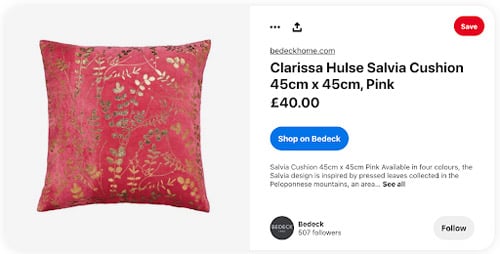
Catalogues
Product catalogues let you upload your entire product range to Pinterest and turn each one into a dynamic Product Pin. You can organise your catalogue so that shoppers can browse product lines and ranges quickly and easily.
How to use Pinterest catalogues
- Upload your entire product catalogue
- Group together similar product types to make them easy to find
- Organise your feed to make sure your products are visible to shoppers who are searching
Here’s an example of a product catalogue in action. Notice how they’ve categorised similar product types to make them easy to find.
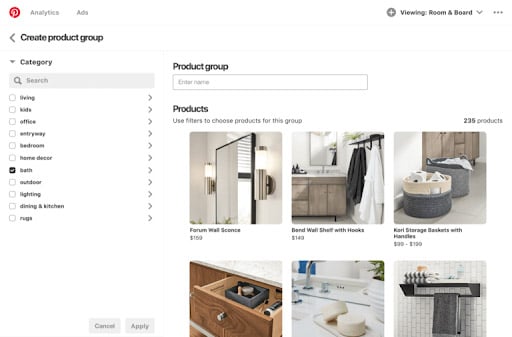
Video Pins
Video Pins are exactly what you’d expect - Pins that showcase video reels rather than static images. They’re great for grabbing attention and keeping shoppers engaged with your products.
How to use Video Pins
- Tell a story around your product or share a customer story
- Showcase a product demo
- Drive viewers to the relevant product page
- Keep your videos short
Frankie Nose Dogs shares a product demo video of their safety harness in action.
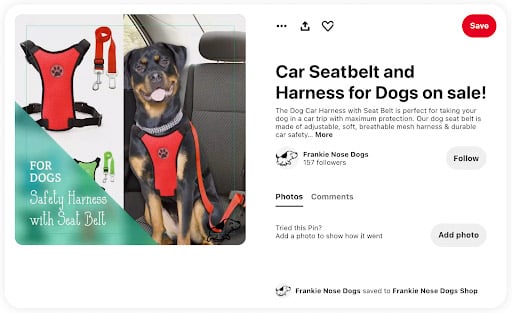
Shop tab
Pinterest has introduced a “Shop” tab that lets users filter their searches to only include Product Pins. This helps buy-ready shoppers take action quickly without having to scroll through endless other Pins.
How to use the Shop tab
- Optimise your Product Pins with prices
- Insert relevant keywords to make sure your Product Pins show up in the right searches
- Take high-quality pictures that stand out
Here’s what the Shop Tab looks like in action from the shopper’s side:
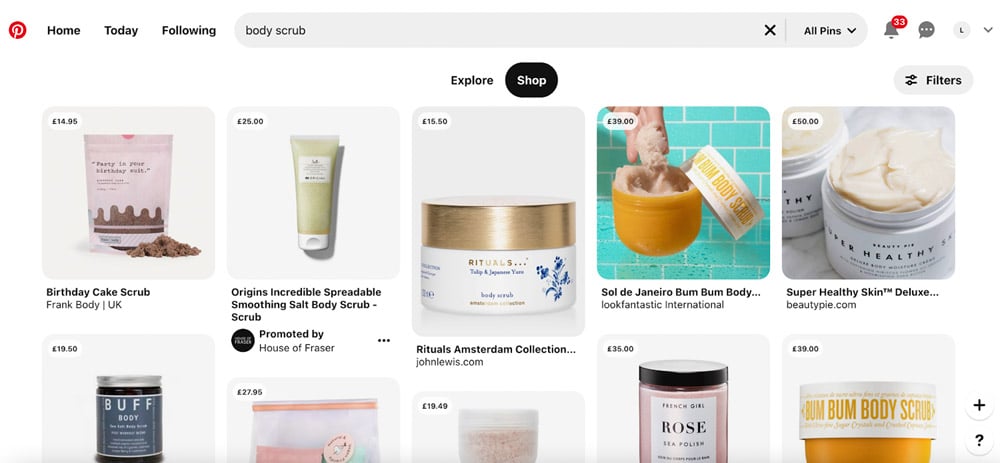
Best Practices for Selling on Pinterest
Selling on Pinterest doesn’t have to be hard. In fact, once you get set up and follow these best practices, you can start making sales on autopilot.
1. Learn Pinterest SEO
Optimising your Pins with the right keywords will help them show up in relevant searches.
If someone types in “manuka honey face mask” and you sell manuka honey face masks, you want it to show up, right?
Start by researching keywords people are already using. The easiest way to do this is to tap into Pinterest’s autocomplete search function. Begin typing the name of your product and see what other phrases people regularly search for around that.
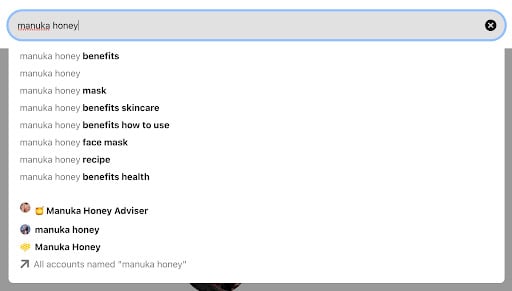
Once you have a list of keywords relevant to your product, sprinkle them through your Pin descriptions and titles for best results.
2. Create shareable Pins
The more people that share your Pins, the more eyeballs you’ll get on them.
Use text to show what your Pin or product is about and add bulleted lists, quotes, and other elements that will encourage people to share.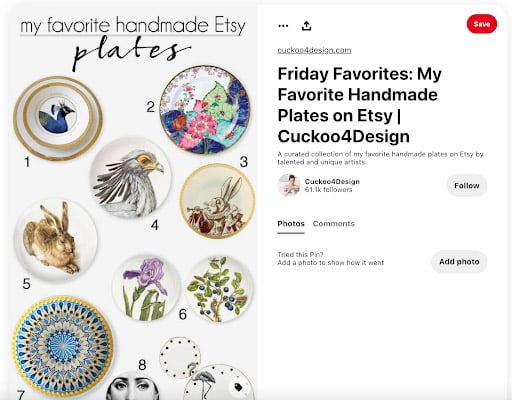
This user has created a visual list of their favourite handmade plates, which can link out to a blog post or a category page where people can buy the products mentioned.
3. Share a variety of content
Not all Pins are created equal. Experiment with different kinds of content, like user-generated content, lifestyle posts, and videos to see which ones resonate with your audience best.
Creating a suite of engaging content like this will help you build a community and increase engagement which will, in turn, generate click-throughs and purchases.
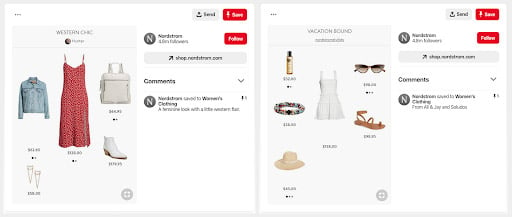
Nordstrom has some great lifestyle Pins, like these ones that highlight outfit ideas.
4. Dig into your analytics
It’s easy to assume you know what content your audience wants to see, but real-life stats never lie.
Your analytics should be a source of inspiration. Tune in to see which Pins have been shared the most and make more of the same.
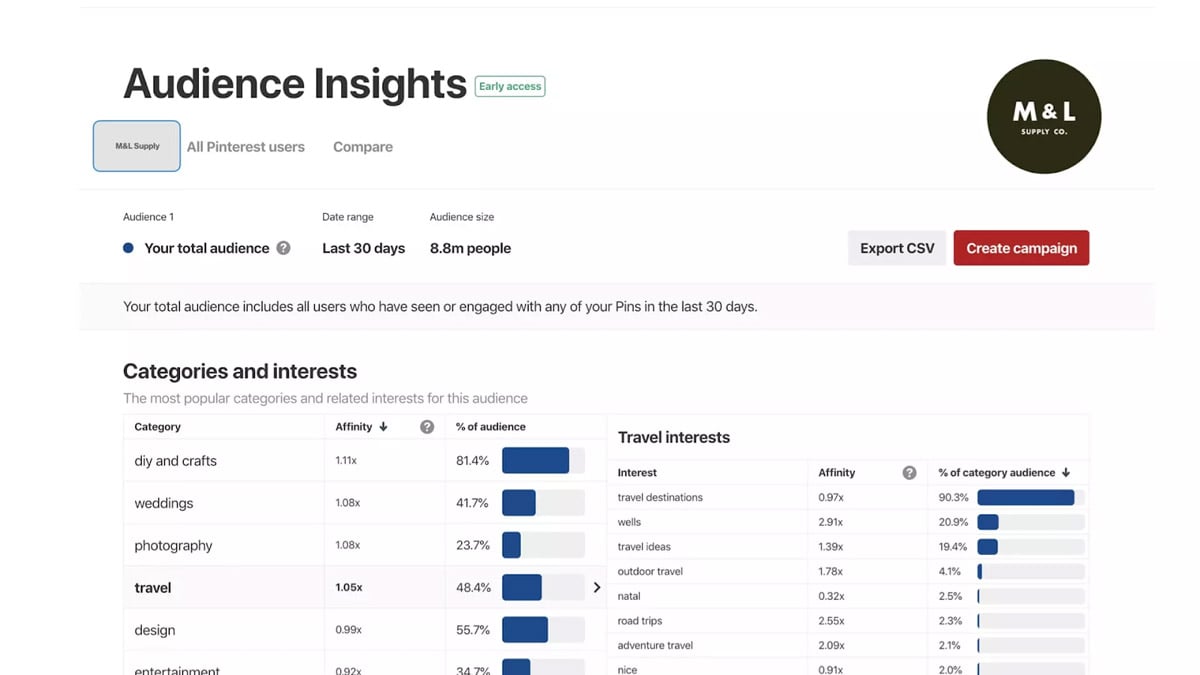
Pinterest’s Business Analytics lets you learn more about your audience, including their favourite categories and interests, but you can also get an overview of the number of impressions your Pins are getting and how much engagement your profile is generating.
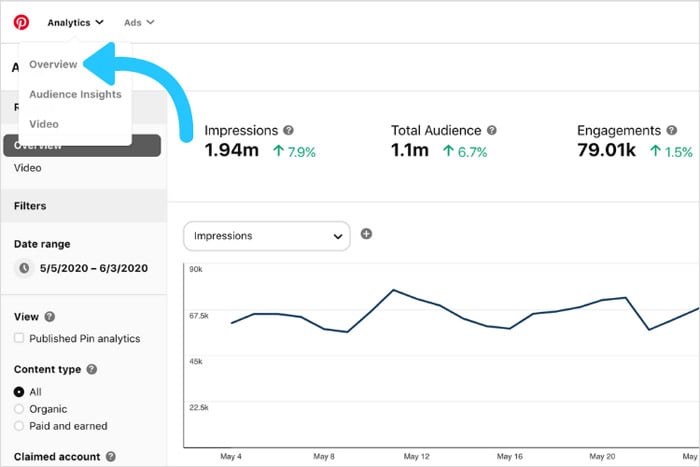
Key metrics you might want to track include:
- Impressions
- Engagements
- Click throughs
5. Brand your account
Your Pinterest page should be an extension of your business. You want customers to instantly recognise that it’s your page they’re on.
Do this by creating a colour scheme for your Pins, using on-brand fonts, and sticking to a streamlined look for each Pin board.
Take inspiration from Darling Jadore:
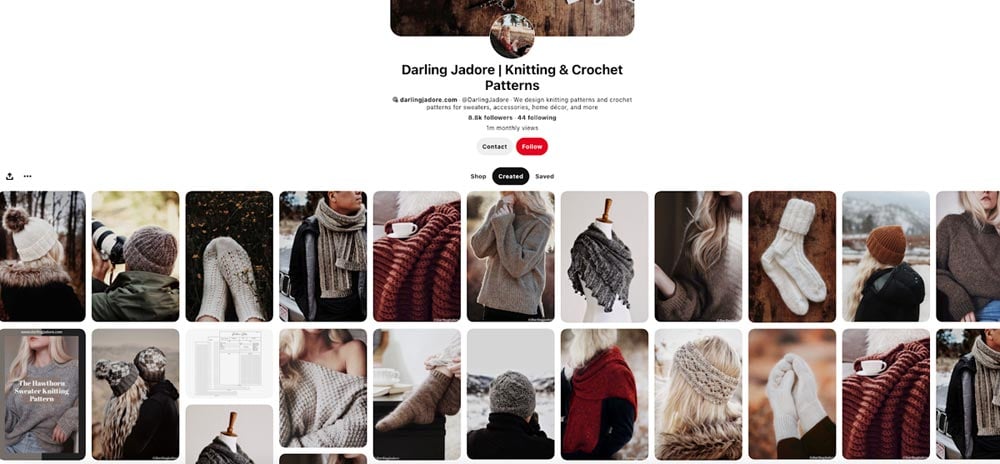
6. Make your store mobile-friendly
More than 80% of all orders on Pinterest come from mobile devices. That’s a huge percentage. Make sure your store aligns with this mobile-first trend and check your Pins are visible (and readable) on smaller devices.
7. High-quality photography is everything
Pinterest is, first and foremost, a picture platform. To stand out, you have to have great photos of your products otherwise customers will simply go elsewhere.
Research shows that 85% of Pinners put visuals first when shopping for clothes and furniture, but we expect this is true across all verticals.
Bella Candle Factory’s photos literally look good enough to eat:
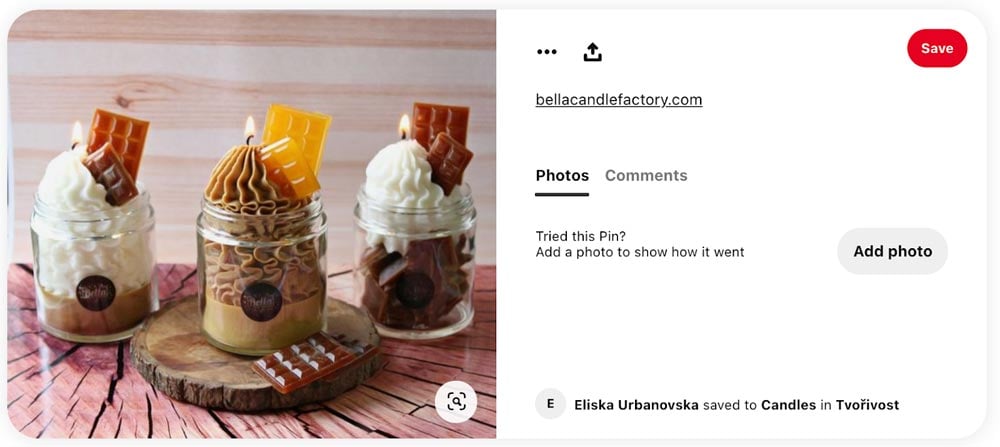
Okay, but what can you sell on Pinterest?
While you can sell pretty much anything on Pinterest, there are some types of products that do better than others. Usually, these products fall under the lifestyle category. We’re talking about things like food, travel, skincare, home decor, and crafts.
For example, more than 56 million Pinners actively engage with home decor content, but there are also plenty of micro-trends and smaller categories that are enjoying their moment in the limelight.
These product categories have a high search volume on Pinterest:
- Outdoor bars +2,795%
- Indian living rooms +2,080%
- Indoor water fountains +917%
- Audio room +803%
- Australian landscaping +784%
- Home coffee stations +751%
- Japanese soaking tubs +563%
- French antiques +384%
- Home theatres +368%
- Spanish bathrooms +309%
- Microgreens growing indoors +223%
The self-care industry is also booming on Pinterest and has seen a 140% increase in searches over the past year. Terms like “elderberry recipes”, “goat milk soap”, and “sleep optimization” are all on the rise.
Get started selling on Pinterest
If Pinterest hasn’t been on your radar until now, it’s time to take action. The fresh surge of shoppers forced online by stay-at-home orders means there’s more potential than ever for e-commerce businesses looking to reach new and engaged audiences.
Start by setting up your Pinterest Business page and creating a collection of Pins that are on-brand, eye-catching, and made to drive traffic to relevant product pages.


